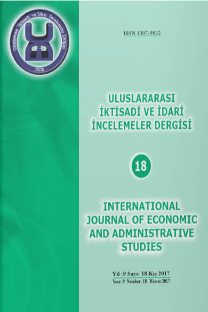THE RELATIVE SENSITIVITIES ANALYSIS BETWEEN THE ECONOMIC GROWTH RATE AND SELECTED MACROECONOMIC VARIABLES: TURKEY CASE
EKONOMİK BÜYÜME ORANI VE SEÇİLMİŞ MAKROEKONOMİK DE-ĞİŞKENLER ARASINDA BAĞIL DUYARLILIK ANALİZİ: TÜRKİYE ÖRNEĞİ
___
ARNOLD, J., JAVORCIK, B.S., MATTOO, A. (2011), Does Services Liberalization Benefit Manufacturing Firms? Evidence from the Czech Republic, Journal of International Economics, 85(1), 136-146.BAHMANI-OSKOOEE, M., DOMAC, I. (1995), Export growth and economic growth in Turkey: Evidence from cointegration analysis, METU Studies in Development, 22, 67-77.
ISENRING, E. A., BAUER, J. D., GASKILL, D., BANKS, M. (2009), The Malnutrition Screening Tool is a useful tool for identifying malnutrition risk in residential aged care, Journal of Human Nutrition and Dietetics, 22(6), 545550.
BORGONOVO, E. AND PECCATI, L. (2004), Sensitivity Analysis in Investment Project Evaluation, International Journal of Production Economics, 90 (1), 17-25.
BORGONOVO, E. AND PECCATI, L. (2006), Uncertainity and Global Sensitivity Analysis in the Evaluation of Investment Projects, Int. J. of Production Economics, 104(1), 62-73.
BUSSIERE, M., FRATZSCHER, M., MULLER, G. (2004), Current Account Dynamics in OECD and EU Acceding Countries: An Intertemporal Approach, European Central Bank Working Paper. No. 311, http://ssrn.com/ abstract=515074, Access date: 15.05.2004.
CALDERON, A., C., CHONG, A., LOAYZO, N. V. (2002), Determinants of Current Account Deficits in Developing Countries, The B.E. Journal of Macroeconomics, 2(1), 1-33.
CHINN, M. AND PARASAD, E. S. (2000), Medium Term Determinants of Current Accounts in Industrial and Developing Countries: An Empirical Exploration, NBER Working Paper. No.7581, http://www.nber.org/papers/w7581, Access date: 01.03.2000.
DAVIDSON R., MACKINNON, J.G. (1993), Estimation and Inference in Econometrics, London: Oxford University Press.
DEBELLE, G. AND FARUQEE H. (1996), What Determines the Current Account?, IMF Working Paper, No.96/58.
DEMİRBAŞ, S. (1999), Cointegration Analysis-Causality Testing and Wagner's Law: The Case of Turkey 1950-1990, University of Leicster Discussion Papers,99/2,http://www2.le.ac.uk/departments/economics/research/discussion- papers/discussion-papers-in-economics, Access date: 01.05.1999.
DOLLAR, D. (1992), Outward-Oriented Developing Economies Really Do More Grow more Rapidly: Evidence form 95 LDCs, 1976-1985, Economic Development and Cultural Change, 40(3), 523-44.
DOMINGUEZ, K. (2005), Economics Perspective in Singapore, (http//www.personalumich.edu/kathrynd/SIngapore), ENDERS, WALTER (1995), Applied Econometric Time Series, John Wiley&Sons: New York.
FRANKEL, J.A., ROMER, D., (1999), Does Trade Cause Growth?, American Economic Review, 89, (3), 379-399.
FINE, B. (2000), Endogenous growth theory: a critical assesment, Cambridge Journal of Economics, 24, (2), 245-265.
FREUND, C. (2005), Current Account Deficits in Industrial Countries: The Bigger They are, The Harder They Fall?, NBER Working Paper, No.11823, İnter- net Adresi; http://www.nber.org/papers/w11823, Access date: 01.11.2005.
GUJARATI, DOMADOR N. (2001), Temel Ekonometri, (Çeviren: Ümit Şenesen, Gülay Günlük Şenesen), 2. Baskı, Literatür Yayıncılık: İstanbul. HALICIOĞLU, F. (2003), Testing Wagner's Law for Turkey, 1960-2000,
Review of Middle East Economics and Finance, 1(2), 129-140. JAYARAMAN, T, K. (2001), Effiency of Fiscal and Monetary Policies in the South Pacific Island Countries: Some Empirical Evidence, Indian Economic Journal, 49, 63-72.
KANDIL, M., GREENE, J. (2002), The Impact of Cyclical Factors on the U.S. Balance of Payments, IMF Working Paper, No.45.
KWIATKOWSKI D., PHILLIPS P., SCHMIDT P., SHIN Y. (1992), "Testing the null hypothesis of stationary against the alternative of a unit root: how sure are we that economic time series have a unit root?", Journal of Econometrics, 54, 159-178.
SARI, R. (2003), Kamu Harcamalarının Dünyada ve Türkiye'deki Gelişimi ve Türkiye'de Ulusal Gelir ile İlişkisi, İktisat İşletme ve Finans Dergisi,18(209), 25-38.
SACHS, J.D., WARNER, A. (1995), Economic Reform and the Process of Global Integration, Brookings Papers on Economic Activity.
SATTAR, Z. (1993), Public Expenditure and Economic Performance: A Comparison of Developed and Low-Income Developing Economies, Journal of International Development, 5(1), 27-49.
ŞİMŞEK, M. (2004), Türkiyede Kamu Harcamaları ve Ekonomik Büyüme, 1965-2002, Atatürk Üniversitesi İİBF Dergisi, 18(1/2), 37-52.
MILLER, S.M., UPADHYAY, M.P. (2000), The Effects of Openness, Trade Orientation, and Human Capital on Total Factor Productivity, Journal of Development Economics, 63, 399- 423.
ÖZMEN, E. ve Furtun G. (1998), Export-led growth hypothesis and the Turkish data: An empirical investication, METU Studies in Development, 25(3), 491-503.
TERZİ, H. (1998), Kamu Harcamaları ve Ekonomik Kalkınma İlişkisi Üzerine Ekonometrik Bir İnceleme, İktisat İşletme ve Finans Dergisi, 142, 67-78.
ULUSOY, A., ZENGİN, A. (1998), Türkiyede Kamu Ekonomisi ve Mali Kriz, XII. Türkiye Maliye Sempozyumu Bildiri Kitabı, İ.Ü Maliye Bölümü Yayınları, No: 83, İstanbul.
UTKULU, U., ÖZDEMİR, D. (2004), Does Trade Liberalization Cause a Long Run Economic Growth in Turkey?, Economics of Planning, 37, 245-266.
YAMAK, R., ZENGİN, A. (1996), Kalman Filtre Yöntemi ve Wagner Yasası, DİE Araştırma Sempozyumu, Ankara.
YİĞİDİM, A., KÖSE, N. (1997), İhracat ve Ekonomik Büyüme Arasındaki İlişki, İthalatın Rolü: Türkiye Örneği (1980-1996), Ekonomik Yaklaşım. 8(26), 71-85.
- ISSN: 1307-9832
- Yayın Aralığı: 4
- Başlangıç: 2008
- Yayıncı: Kenan ÇELİK
KREDİ DERECELENDİRME KURULUŞLARI VE YUNANİSTAN BORÇ KRİZİ
WORLD IN 2023: ESTIMATION BY POPULATION, CAPITAL MARKETS AND ECONOMIC SIZE
Muhammed V. KAYA, İbrahim BOZKURT, RIFAT KARAKUŞ, Sezer ÖKSÜZ
AFET YÖNETİMİNDE İÇSEL DENETİM ARACI OLARAK ETİK
DOĞRUDAN YABANCI YATIRIMLAR VE PORTFÖY YATIRIMLARI VOLATİLİTESİ ARASINDA NEDENSELLİK İLİŞKİSİ
2023’DE DÜNYA: NÜFUS, SERMAYE PİYASALARI ve EKONOMİK BÜYÜKLÜK İLE TAHMİN EDİLMESİ
Muhammet KAYA, İbrahim BOZKURT, Rıfat KARAKUŞ, Sezer ÖKSÜZ
Murat ATİK, Yaşar KÖSE, Bülent YILMAZ
GELİŞMEKTE OLAN ÜLKELERE YÖNELİK SERMAYE HAREKETLERİ VE EKONOMİK SONUÇLARI
